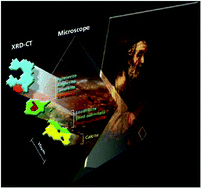Unravelling the spatial dependency of the complex solid-state chemistry of Pb in a paint micro-sample from Rembrandt's Homer using XRD-CT†
Abstract
The surface of many Old Master paintings has been affected by the appearance of whitish lead-rich deposits, which are often difficult to fully characterise, thereby hindering conservation. A paint micro-sample from Rembrandt's Homer was imaged using X-ray Diffraction Computed Tomography (XRD-CT) in order to understand the evolving solid-state Pb chemistry from the painting surface and beneath. The surface crust was identified as a complex mixture of lead sulfates. From the S : Pb ratios throughout the paint layer, we can conclude that S is from an external source in the form of SO2, and that the nature of Pb–SO4 product is dependent on the degree of diffusion/absorption of SO2 into the paint layers.



 Please wait while we load your content...
Please wait while we load your content...